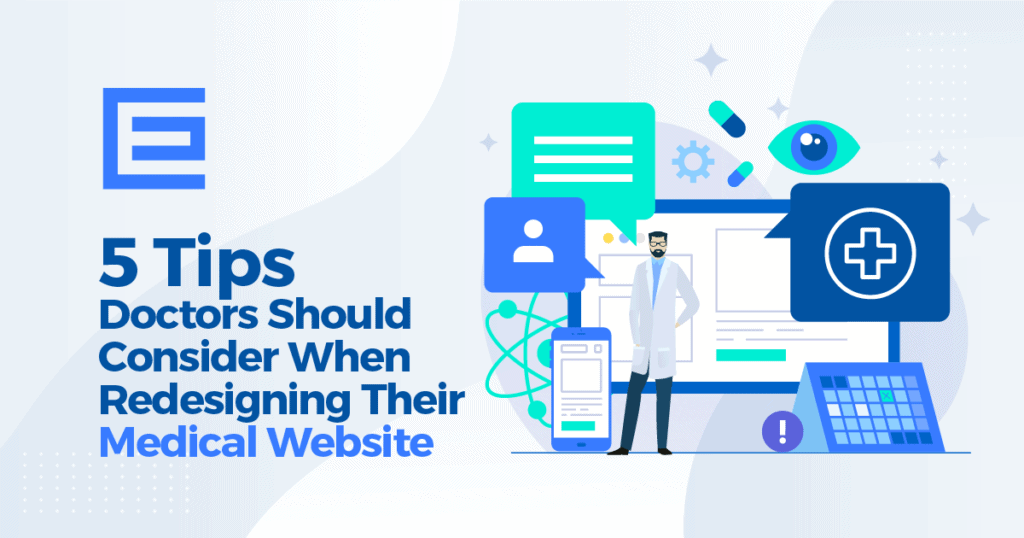As a physician, your website design is important in establishing your brand, impressing prospective patients, informing and educating, and assisting patients in accomplishing tasks and communication for your practice. Every doctor’s office is different. The office for an orthopedic sports doctor will look different than a pediatrician’s office. And, so should the website that reflects a specific type of medicine. The website design for your practice should appeal to the practice’s population.
Your website says a lot about your practice. It is a digital age and the majority of people use the internet to do business and communicate. Regardless of whether you are a sole practitioner or a hospital, a beautiful, easy-to-navigate site enhances your image and can attract new patients.
We have put together five (5) tips to consider when you are redesigning your medical website. Following these tips will create a website that better serves your patients and people who are needing your services.

Tip #1: Make It Easy to Navigate
The navigation structure of your medical website is a major component of a well-designed site. If your visitors can’t find where to get the information they need, frustration mounts and can cause them to take business elsewhere. Someone who is sick and seeking medical assistance doesn’t have time to stumble around an unintuitive website. Studies have shown that a high percentage of consumers indicate that easy navigation is the most important website feature.
Navigation must be thought through carefully and be designed in a way that the user understands. It should be easy to find relevant information, using a well-designed menu that displays the most important pages and uses a hierarchical structure that indicates which pages take precedence. Strategically place call-to-action buttons throughout the web pages to lead users directly to high-priority pages. Valuable pages may include your online booking system, patient portal, and office staff backgrounds with pictures.
Tip #2: Make It Mobile-Friendly
With 80% of all web visitors using mobile devices when searching for goods and services on the internet, your website must be mobile-responsive. “Mobile-responsive” means that the design adjusts to fit the device’s screen size be it a tablet, smartphone, or computer. A design that has incorporated features adjusted for mobile devices allows users the convenience of interacting using their preferred devices without having to perform gyrations like pinching or scrolling. Ease of use is imperative for your website, given the type of information you are presenting and the market you are serving. Implement these tips for designing a mobile-friendly medical website that connect with patients:
Optimize Your Homepage
Create a homepage that contains short pops of information about the practice. This allows the visitors to quickly find the content they need and stay engaged as they learn more about the services you offer.
Include a Hamburger Navigation Menu
A hamburger menu is a collapsed version of your navigation menu that is highly visible in the top right corner of your site on mobile devices. This allows the reader to quickly and easily access the content that is most relevant to them.
Allow Visitors to Click and Call
The ability to simply click and call to set up an appointment or ask questions is an important feature on a mobile device.
Tip #3: Include Valuable Content
The content you provide on the website can make you stand out from competing practitioners. Many times, your site visitors are looking for content that is informative and interesting. Providing it will encourage existing patients to visit regularly while also stimulate first-time visitors to click through to other content. The information on your website can assist users in determining whether their medical needs match your expertise. Additionally, content marketing is more affordable than traditional marketing and generates three times more leads.
When you are designing your website, create sections for regular blog posts, questions and answers, and patient reviews. Posting fresh relevant content in a blog section that has topics your patient base is interested in, like major advancements or news in your field of medicine, both provides interesting information and establishes you as an authority.
Testimonials are a powerful resource to potential patients who have related problems. Reading what others have to say about their experience can put you at the top of their potential list of healthcare specialists.
Tip #4: Add Strong Images
Strong images on your website improves the attractiveness and, therefore, better engages your visitors. Breaking up text with relevant images produces over 600% higher engagement than pages with only text. For a medical website, designing pages that include high-quality photos allows you to showcase the quality of products and services you provide. Again, photos can help prospective patients to determine if your offerings align with their needs. And, people want to see high-quality images and videos of staff and your facility when booking appointments.
However, you need to strategically place your images. Too many can be distracting and disruptive in understanding the content. All your blogs need to include images that add to the content. A large percentage of the population are visual learners so pictures, graphics, charts, and other images greatly enhance the ability of the readers to understand the content.
Tip #5: Identify and Convey Your Brand Messaging
It’s critical that your medical website design clearly conveys your service and defines what your practice is and how it is differentiated from competitors. Don’t forget that patients have numerous options when selecting a healthcare provider. Make it easily apparent what kind of medical service you offer and the patients you treat. The user needs to determine these things quickly from your site. They don’t necessarily have the time to search in-depth for this information and they may give up if the information isn’t available immediately.
Think of your website as your office – patients entering that space can make fast judgements about your practice in its branding and messaging. Consider key elements for the website such as the color scheme, the font type and size, and the images. By clearly defining your brand, you position your practice as a respectable and trustworthy choice for patients. These elements of branding tie together in a way that accurately communicates what your practice stands for and who it serves.
Contact TheeDigital When Redesigning Your Medical Practice Website
Are you looking for more internet marketing and web design advice? TheeDesign provides website design for many businesses such as yours. Our marketing and design specialists are experts at assisting you in defining the aspects of your medical practice that you want your website to incorporate. Let us help you to create a medical website that creates a superior user experience and portrays your practice just like you want it. Contact us today at 919-372-3599 or schedule a consultation.
Tags: Healthcare Marketing • Web Design


